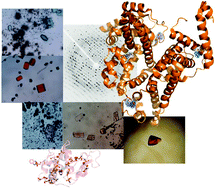Principles and methods used to grow and optimize crystals of protein–metallodrug adducts, to determine metal binding sites and to assign metal ligands
Abstract
The characterization of the interactions between biological macromolecules (proteins and nucleic acids) and metal-based drugs is a fundamental prerequisite for understanding their mechanisms of action. X-ray crystallography enables the structural analysis of such complexes with atomic level detail. However, this approach requires the preparation of highly diffracting single crystals, the measurement of diffraction patterns and the structural analysis and interpretation of macromolecule–metal interactions from electron density maps. In this review, we describe principles and methods used to grow and optimize crystals of protein–metallodrug adducts, to determine metal binding sites and to assign and validate metal ligands. Examples from the literature and experience in our own laboratory are provided and key challenges are described, notably crystallization and molecular model refinement against the X-ray diffraction data.

- This article is part of the themed collection: Recent Review Articles


 Please wait while we load your content...
Please wait while we load your content...